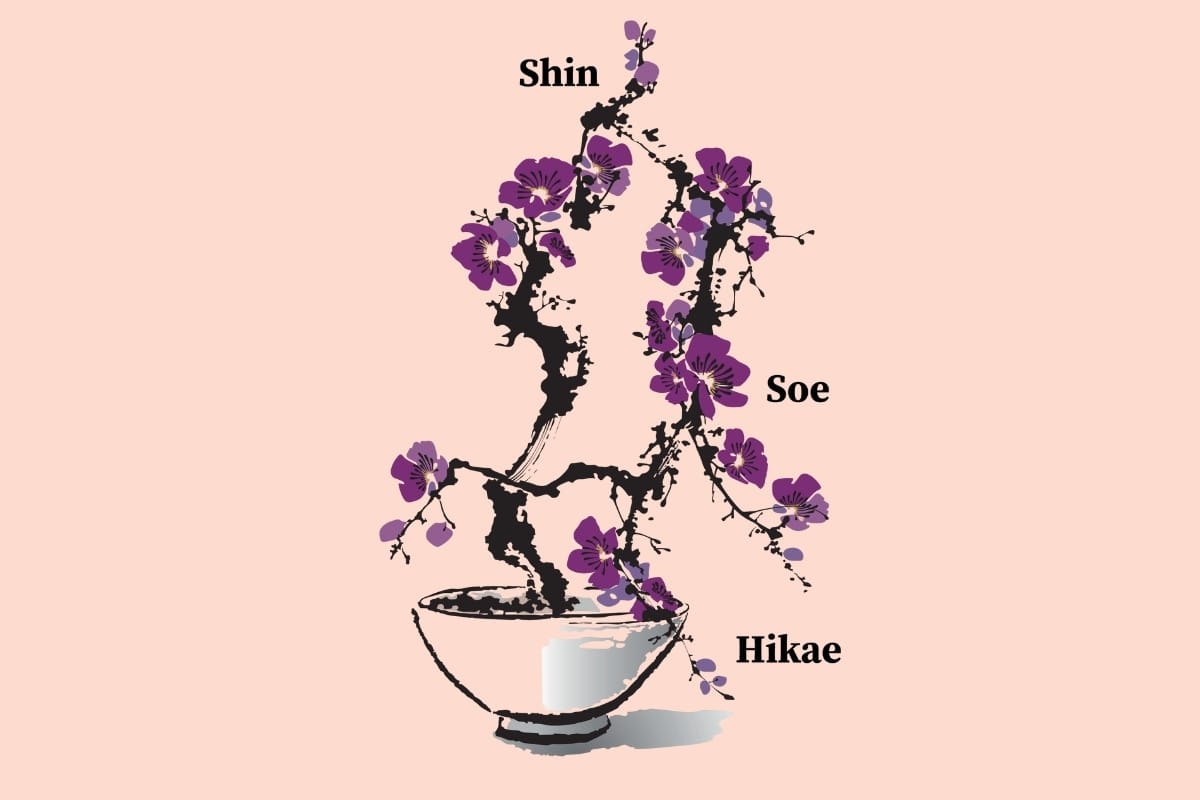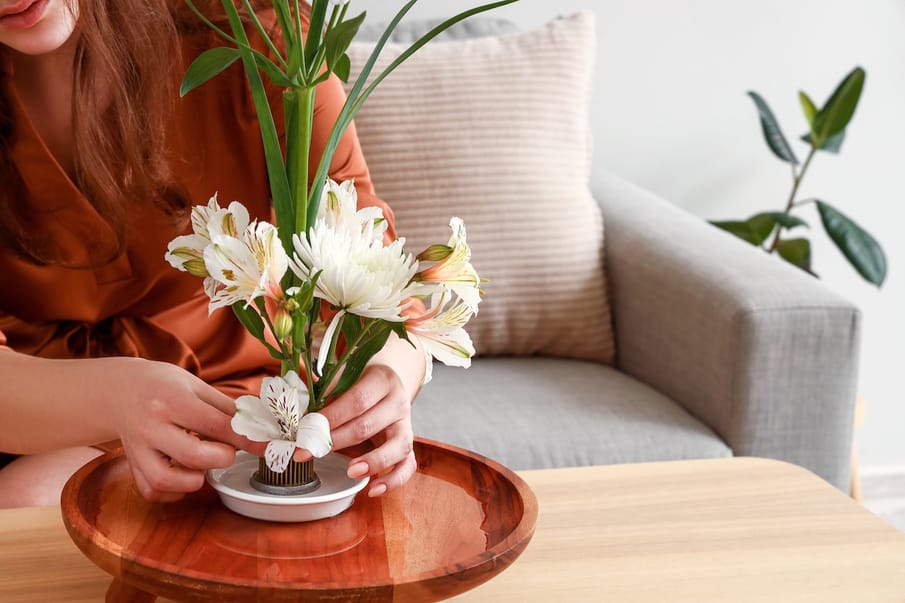Does buying a bouquet brighten up your day? Try this Japanese tradition, which cultivates presence and self-expression…
"Japan’s natural beauty is absolutely breathtaking,” says floral designer and founder of Ume, Jessica Fossey. “Every season brings new magic, and there is an element of tranquility that is almost indescribable.”
Originally a professional dancer, Jessica lived in Tokyo, where she became mesmerised by the way flowers intertwined with culture. “I soon discovered Japan’s ability to showcase florals on a scale like no other.”
But you don’t have to live near the sweet fragrance of wisteria gardens or the soft maple leaves overlooking Mount Fuji to explore the Japanese power of flowers. In fact, there is one practice that anyone can try at home: ikebana.
What is ikebana?
Ikebana (pronounced ee-kay-baa-nuh) is the Japanese art of flower arranging, which translates as ‘bringing life to flowers’. Instead of putting blooms in any old vase, ikebana is an intentional act that encourages a meditative state, creative self-expression, and a deep connection to nature. In a world that rushes us from one task to the next, this mindful process is an invitation to slow down and marvel at the natural rhythms of life.
More than a hobby
Working with flowers isn’t just about creating a decorative piece – the activity offers many healing benefits. One study, in the Journal of Death and Dying, found floral arrangement sessions helped family caregivers at a hospice centre reduce stress and anxiety levels. Other research, including a study in Evolutionary Psychology, show sessions can lead to a significant improvement in mood, especially in children, who benefit from increased self-esteem.
When we see a bunch of flowers our brain releases dopamine (the feel-good neurotransmitter), but taking time to arrange flowers takes things one step further. The act of carefully choosing your blooms, pondering colour schemes and placements, uses cognitive skills such as decision-making, planning, and spatial awareness. Keeping the mind engaged in this way encourages mindfulness – making ikebana the ideal activity for those who find the stillness of meditation challenging.
How is ikebana different?
Where western floral arranging tends to prioritise aesthetics, ikebana is considered a spiritual practice. There’s no rush to complete the task, but instead, a sense of surrendering to the process as pleasurable in itself.
“Without a doubt, it taught me to slow down and appreciate the moment,” says Jessica. “Each flower speaks to you in ways you don’t see straight away, and teaches you to live with patience.”
Empty space is also key. Instead of a vase that overflows with flowers in full bloom, ikebana displays are intentionally sparse and incorporate branches, leaves, stems, and even dead or withered plants. While individual expression is at the heart of ikebana, traditional arrangements consist of three fundamental elements: shin, soe, and hikae.
How the elements of ikebana work together to create a feeling of balance
- The tallest stem (shin) symbolises heaven or the spiritual realm.
- The mid stem (soe) represents humanity, and connects the shin and hikae.
- The lowest and smallest element (hikae) symbolises Earth, or the physical realm.

How to try ikebana
Explore this mindful practice at home with these simple steps:
Consider the space
Start by thinking about where you plan to place your finished arrangement. This will inform the kind of vase you use, the flowers you source, and how they are arranged. E.g. a large window may call for tall blooms in an oversized vase, whereas a coffee table might suit a shallow bowl and shorter stems.
Find your foliage
Jessica suggests heading to your back garden or local market, and to choose three small bunches of flowers and foliage. “Think about contrasting or complimenting colours, shapes, and textures,” she says. “Your eye will be drawn to a certain flower or colour, just go with your gut, and build your other two choices based on what resonates.”
Choose your vessel
Ikebana considers the vase an important design element, with many opting for transparent glass vases to mimic how plants grow in nature. But similarly, a ceramic, metal, or wooden vessel can work just as well. “If you are using a vase, try to be aware of the stem length and vase neck length,” says Jessica. “Flowers need to be able to breathe and have space to move freely, as opposed to sitting the same height as the vase.”
According to Jessica, ‘flower frogs’ are the secret ingredient to holding and supporting your blooms. “They are a small pad of ‘pins’ that sit facing upwards for the flowers to interlock and hold on to. They are versatile, and can be used in vases and bowls.” You’ll also need a sharp pair of scissors or secateurs.
Go with the flow
Once you’ve got all your items, take a minute to set the tone for your ikebana experience, in order to embody the mindfulness aspect. “To help you feel relaxed and at ease, pop your favourite album on in the background,” says Jessica. “Listening to music can change our emotions. I feel it is important to be connected and open to welcoming new feelings of joy, purity, and happiness through another form of art.
“Unwrap your flowers, and remove any thorns and excess leaves lower down the stem that may sit below the waterline. To prolong lifespan, cut the very end of the stem on a diagonal angle to ensure the flower can drink effectively, and receive as much water to the head as possible.”
Jessica suggests experimenting with stem heights, focusing on the triangle framework of a main stem, secondary stem, and supporting element. “By creating with various heights and angles, this incorporates harmony between the flowers, space, depth, and overall composition,” says Jessica. “A heavier head or bigger focal flower, such as a hydrangea, tends to gravitate towards the base of your arrangement giving some weight behind it. A delicate flower, such as the butterfly ranunculus, will give fluidity, height, and add an essence of feminism, preferring to sit higher up in the arrangement.”
Make it your own
In the spirit of ikebana, Jessica suggests trusting your intuition to know how to work with the natural elements: “Each flower is unique and guides you through. It will tell you where it would like to sit and be placed.” Try out different placements, and rotate the vase to look at your creation from several angles before settling on your final design – every artist must go through a series of trials and errors to create any masterpiece.
Above all, Jessica stresses that working with flowers isn’t about having a grand vision or artistic prowess: “Art is subjective, and I don’t believe anyone can make a ‘bad’ arrangement when using such beautiful materials [...] Flowers are a truly special form of unspoken art.”


Comments